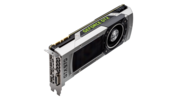NVIDIA GeForce GTX 970 vs Intel UHD Graphics 620 vs Intel Iris Plus Graphics 655
NVIDIA GeForce GTX 970
► remove from comparison
The Nvidia GeForce GTX 970 is a high end desktop graphics card based on the Maxwell architecture. As the faster GTX 980, the GTX 970 uses the GM204 chip, but with reduced shaders (2048 vs. 1664) and TMUs (128 vs 103). The graphics card is equipped with 4 GB GDDR5 (7 GHz effective). 3.5 GB of the 4 GB are connected with 224 Bit, the rest only with a 32 Bit interface. This can lead to some stuttering or reduced frame rates in games that use the full 4 GB. The similar named mobile GeForce GTX 970M is clearly slower as it features only 1280 shader cores.
Despite the unique memory configuration, the GTX 970 performs on average on par with the older GeForce GTX 780 Ti or a AMD Radeon R9 290X.
The GM204 supports CUDA, 3D Vision, PhysX, GeForce Experience, Surround, GameStream, GPU Boost 2.0, Adaptive Vertical Sync / G-SYNC, SLI, DSR, MFAA and Virtual Reality latency improvements.
The Maxwell architecture is very power efficient. While gaming, the card only uses as much power as the Radeon R9 285 which is more than 35% slower on average.
Intel UHD Graphics 620
► remove from comparison
The Intel UHD Graphics 620 (GT2) is an integrated graphics unit, which can be found in various ULV (Ultra Low Voltage) processors of the Kaby Lake Refresh generation (8th generation Core). Compared to the similar named Intel HD Graphics 620 in the 2016 Kaby Lake CPUs, only the name changed from HD to UHD. It is clocked with up to 1.150 MHz and therefore 100 MHz higher than the old HD Graphics 620 (max. 1.050 MHz) and offer a comparable performance. Due to its lack of dedicated graphics memory or eDRAM cache, the HD 620 has to access the main memory (2x 64bit DDR3/DDR4).
Performance
The exact performance of the UHD Graphics 620 depends on various factors like L3 cache size, memory configuration (DDR3/DDR4) and maximum clock rate of the specific model and as is similar to the Intel HD Graphics 620 and Intel HD Graphics 630. Compared to the average HD Graphics 620, the UHD graphics profits from the quad-core CPU a bit in our gaming benchmarks. Therefore, should be positioned between a GeForce 910M and 920M dedicated graphics card from Nvidia. For games, the drivers however are not that fast updated and tested as with GeForce graphics cards. In our tests, the UHD 620 is most suited for casual games like Team Fortress 2, Rocket League or Farming Simulator 17. See below for a list of modern games tested with various models.
Features
The revised video engine now supports H.265/HEVC Main10 profile in hardware with 10 bit colors. Furthermore, Googles VP9 codec can also be hardware decoded. The first models do not support HDCP 2.2 and therefore Netflix 4K. This was added with the new models in 2017 and beginning of May 2017 also the older CPU models like the i3-7100U are now shipped with a new S-Spec Code that supports HDCP 2.2. HDMI 2.0 however is still only supported with an external converter chip (LSPCon).
Power Consumption
The UHD Graphics 620 can be found in mobile processors specified at 15 W TDP and is therefore suited for compact laptops and ultrabooks. The power consumption during playing The Witcher 3 (with an external monitor) was comparable to a Intel HD Graphics 620 based laptop and on the lowest end of all of our measurements. Dedicated GPUs, like the GeForce 940MX, needed a lot more power.
Intel Iris Plus Graphics 655
► remove from comparison
The Intel Iris Plus Graphics 655 (GT3e) is a processor graphics card announced in September 2017. As the successor to the Intel Iris Graphics 650 (Kaby Lake), the Iris Plus Graphics 655 is used for 28-Watt Coffee Lake-U models. The biggest difference is the doubled eDRAM-cache at 128 MB. There should not be any big changes compared to the Iris Graphics 650.
The so called GT3e version of the Kaby Lake GPU still has 48 Execution Units (EUs), which can reach up to 1200 MHz (previously 1100 MHz) depending on the model. Besides eDRAM cache, the Iris 655 can also access the system memory (2x 64 Bit DDR3L-2133/DDR4-2400) via processor interface.
Compared to the Iris Plus 640 from the 15-Watt models, the Iris 655 only has a slightly higher maximum clock as well as almost twice the TDP, which allows a better utilization of the Turbo Boost potential.
Performance
The exact performance of the Iris Plus Graphics 655 depends on the CPU model, because maximum clock as well as the size of the L3 cache can differ a bit. The system memory (DDR3/DDR4) will influence the performance as well.
The fastest chips are high-clocked Core i7 models like the Core i7-8559U. Depending on the game, the Iris Plus 655 will probably be on par with a dedicated GeForce 930M or GeForce 940MX and can handle smooth gameplay in modern titles in low up to medium settings.
Features
The reworked video engine now fully supports hardware decoding of H.265/HEVC videos. Contrary to Skylake, however, Kaby Lake can now also decode H.265/HEVC Main 10 with a 10-bit color depth as well as Google's VP9 codec. The video output is possible via DP 1.2/eDP 1.3 (up to 3840 x 2160 @60 Hz), whereas HDMI is also supported in the older 1.4a standard. An HDMI 2.0 output can be added via converter from DisplayPort. The GPU can drive up to three displays simultaneously.
Power Consumption
The Iris Plus Graphics 655 is used for 28-Watt processor and therefore small/medium-sized notebooks.
| NVIDIA GeForce GTX 970 | Intel UHD Graphics 620 | Intel Iris Plus Graphics 655 | ||||||||||||||||||||||||||||||||||||||||||||||||||||||||||||||||||||||||||||||||||||||||||||||||||||
| Gen. 9.5 Series |
|
|
| |||||||||||||||||||||||||||||||||||||||||||||||||||||||||||||||||||||||||||||||||||||||||||||||||||
| Codename | GM204 | Kaby-Lake-Refresh GT2 | Kaby Lake GT3e | |||||||||||||||||||||||||||||||||||||||||||||||||||||||||||||||||||||||||||||||||||||||||||||||||||
| Architecture | Maxwell | Gen. 9.5 | Gen. 9.5 Kaby Lake | |||||||||||||||||||||||||||||||||||||||||||||||||||||||||||||||||||||||||||||||||||||||||||||||||||
| Pipelines | 1664 - unified | 24 - unified | 48 - unified | |||||||||||||||||||||||||||||||||||||||||||||||||||||||||||||||||||||||||||||||||||||||||||||||||||
| Core Speed | 1050 - 1178 (Boost) MHz | 300 - 1150 (Boost) MHz | 300 - 1200 (Boost) MHz | |||||||||||||||||||||||||||||||||||||||||||||||||||||||||||||||||||||||||||||||||||||||||||||||||||
| Memory Speed | 3500 MHz | |||||||||||||||||||||||||||||||||||||||||||||||||||||||||||||||||||||||||||||||||||||||||||||||||||||
| Memory Bus Width | 224 + 32 Bit | |||||||||||||||||||||||||||||||||||||||||||||||||||||||||||||||||||||||||||||||||||||||||||||||||||||
| Memory Type | GDDR5 | DDR3/DDR4 | DDR3/DDR4 | |||||||||||||||||||||||||||||||||||||||||||||||||||||||||||||||||||||||||||||||||||||||||||||||||||
| Max. Amount of Memory | 4 GB | |||||||||||||||||||||||||||||||||||||||||||||||||||||||||||||||||||||||||||||||||||||||||||||||||||||
| Shared Memory | no | yes | yes | |||||||||||||||||||||||||||||||||||||||||||||||||||||||||||||||||||||||||||||||||||||||||||||||||||
| API | DirectX 12_1, OpenGL 4.5 | DirectX 12_1, OpenGL 4.4 | DirectX 12_1, OpenGL 4.5 | |||||||||||||||||||||||||||||||||||||||||||||||||||||||||||||||||||||||||||||||||||||||||||||||||||
| Power Consumption | 145 Watt | |||||||||||||||||||||||||||||||||||||||||||||||||||||||||||||||||||||||||||||||||||||||||||||||||||||
| Transistors | 5.2 Billion | |||||||||||||||||||||||||||||||||||||||||||||||||||||||||||||||||||||||||||||||||||||||||||||||||||||
| technology | 28 nm | 14 nm | 14 nm | |||||||||||||||||||||||||||||||||||||||||||||||||||||||||||||||||||||||||||||||||||||||||||||||||||
| Features | CUDA, 3D Vision, PhysX, GeForce Experience, Surround, GameStream, GPU Boost 2.0, Adaptive Vertical Sync, G-SYNC, SLI | QuickSync | QuickSync | |||||||||||||||||||||||||||||||||||||||||||||||||||||||||||||||||||||||||||||||||||||||||||||||||||
| Date of Announcement | 19.09.2014 | 01.09.2017 | 01.09.2017 | |||||||||||||||||||||||||||||||||||||||||||||||||||||||||||||||||||||||||||||||||||||||||||||||||||
| Link to Manufacturer Page | www.geforce.com | |||||||||||||||||||||||||||||||||||||||||||||||||||||||||||||||||||||||||||||||||||||||||||||||||||||
| Theoretical Performance | 883 TFLOPS FP16, 442 TFLOPS FP32, 110.4 TFLOPS FP64 | |||||||||||||||||||||||||||||||||||||||||||||||||||||||||||||||||||||||||||||||||||||||||||||||||||||
| Displays | HDMI 1.4, DisplayPort 1.2 | |||||||||||||||||||||||||||||||||||||||||||||||||||||||||||||||||||||||||||||||||||||||||||||||||||||
| Predecessor | HD Graphics 620 |
|
| |||||||||||||||||||||||||||||||||||||||||||||||||
Benchmarks
3DM Vant. Perf. total + NVIDIA GeForce GTX 970
specvp12 sw-03 + Intel UHD Graphics 620
Cinebench R15 OpenGL 64 Bit + NVIDIA GeForce GTX 970
GFXBench T-Rex HD Offscreen C24Z16 + NVIDIA GeForce GTX 970
Average Benchmarks NVIDIA GeForce GTX 970 → 100% n=22
Average Benchmarks Intel UHD Graphics 620 → 19% n=22
Average Benchmarks Intel Iris Plus Graphics 655 → 100% n=22
* Smaller numbers mean a higher performance
1 This benchmark is not used for the average calculation
Game Benchmarks
The following benchmarks stem from our benchmarks of review laptops. The performance depends on the used graphics memory, clock rate, processor, system settings, drivers, and operating systems. So the results don't have to be representative for all laptops with this GPU. For detailed information on the benchmark results, click on the fps number.

EA Sports WRC
2023
Total War Pharaoh
2023
Counter-Strike 2
2023
Armored Core 6
2023
Atlas Fallen
2023
Dead Island 2
2023
Company of Heroes 3
2023
Sons of the Forest
2023
Atomic Heart
2023
Dead Space Remake
2023
High On Life
2023
Vampire Bloodhunt
2022
Ghostwire Tokyo
2022
Cyberpunk 2077 1.6
2022
GRID Legends
2022
Elden Ring
2022
Farming Simulator 22
2021
Riders Republic
2021
Back 4 Blood
2021
Alan Wake Remastered
2021
F1 2021
2021
Cyberpunk 2077 1.0
2020
Yakuza Like a Dragon
2020
Watch Dogs Legion
2020
FIFA 21
2020
Star Wars Squadrons
2020
Serious Sam 4
2020
Horizon Zero Dawn
2020
Death Stranding
2020
F1 2020
2020
Valorant
2020
Gears Tactics
2020
Doom Eternal
2020
Hunt Showdown
2020
Escape from Tarkov
2020
Hearthstone
2020
Fall Guys
2020
Need for Speed Heat
2019
GRID 2019
2019
FIFA 20
2019
Borderlands 3
2019
Control
2019
F1 2019
2019
Anno 1800
2019
The Division 2
2019
Dirt Rally 2.0
2019
Far Cry New Dawn
2019
Metro Exodus
2019
Apex Legends
2019
Just Cause 4
2018
Darksiders III
2018
Battlefield V
2018
Farming Simulator 19
2018
Fallout 76
2018
Hitman 2
2018
Forza Horizon 4
2018
FIFA 19
2018
F1 2018
2018
Monster Hunter World
2018
The Crew 2
2018
Far Cry 5
2018
X-Plane 11.11
2018
Fortnite
2018
Call of Duty WWII
2017
The Evil Within 2
2017
FIFA 18
2017
Ark Survival Evolved
2017
F1 2017
2017
Team Fortress 2
2017
Dirt 4
2017
Rocket League
2017
Prey
2017
For Honor
2017
Resident Evil 7
2017
Watch Dogs 2
2016
Dishonored 2
2016
Titanfall 2
2016
Farming Simulator 17
2016
Battlefield 1
2016
Civilization 6
2016
Mafia 3
2016
FIFA 17
2016
Overwatch
2016
Doom
2016
Need for Speed 2016
2016
Hitman 2016
2016
The Division
2016
Far Cry Primal
2016
XCOM 2
2016
Rainbow Six Siege
2015
Just Cause 3
2015
Fallout 4
2015
Anno 2205
2015
FIFA 16
2015
World of Warships
2015
Metal Gear Solid V
2015
Mad Max
2015
Dota 2 Reborn
2015
The Witcher 3
2015
Dirt Rally
2015
GTA V
2015
Battlefield Hardline
2015
Evolve
2015
Far Cry 4
2014
F1 2014
2014
Ryse: Son of Rome
2014
Alien: Isolation
2014
Fifa 15
2014
Sims 4
2014
Risen 3: Titan Lords
2014
GRID: Autosport
2014
Watch Dogs
2014
Thief
2014
X-Plane 10.25
2013
Battlefield 4
2013
Company of Heroes 2
2013
Metro: Last Light
2013
BioShock Infinite
2013
Tomb Raider
2013
Crysis 3
2013
Counter-Strike: GO
2012
Diablo III
2012
Anno 2070
2011
StarCraft 2
2010Average Gaming NVIDIA GeForce GTX 970 → 100%
Average Gaming 30-70 fps → 100%
Average Gaming Intel UHD Graphics 620 → 15%
Average Gaming 30-70 fps → 26%
Average Gaming Intel Iris Plus Graphics 655 → 19%
Average Gaming 30-70 fps → 26%
For more games that might be playable and a list of all games and graphics cards visit our Gaming List











































































